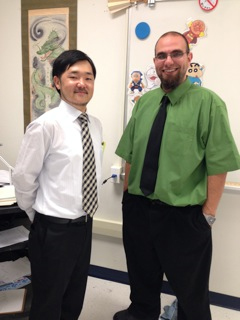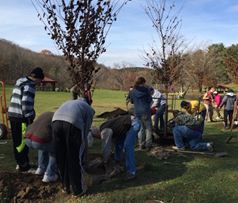

 2014 J-LEAP Report
2014 J-LEAP Report
Shaler Area High School
Pittsburgh, PA
Hello and Konnichiwa! My name is Shunji Iwasaki and I have been working at Shaler Area High School in Pittsburgh, Pennsylvania since August 2014 with my Lead Teacher, Balsomico-sensei. I cannot believe that it has already been four months, but I think that is because I am enjoying this job and having a lot of meaningful experiences here in Pittsburgh. Shaler Area High School is located on the northern part of Pittsburgh. The image I had of Pittsburgh is a big urban city in a central area, but the school where I am working at is surrounded by forests and deer. Every morning when I am driving to school, I am shaking in my boots worrying if a deer will run out into the road. And I am also afraid of cold weather here because I used to live in Hawaii for years and I am not familiar with spending life in freezing air and heavy snow. Though, I am having much fun here so far.
There are about 1500 students enrolled in Shaler Area High School, but the school is less diverse compared to other schools in Pittsburgh. According to the Pennsylvania Department of Education’s school report, this high school is ninety percent White. It is the only school that has the Advanced Placement Japanese course in Western Pennsylvania, and Shaler Area Middle School also has a Japanese course, so it seems that this school district has a positive view when it comes to learning Japanese. There are five levels of Japanese from Levels 1 through 5 (Level 5 is Advanced Placement Class) and there are six classes with more than 90 students total. Balsomico-sensei has been focused on developing his communicative ability, and by having me, we can demonstrate authentic conversational examples based on real-life settings. As an effective approach, Balsomico-sensei and I have been lying to students that I understand English but I cannot speak English, and surprisingly it seems like the students believe the lie. It is hard sometimes because I really want to communicate with students more in English, but I need to keep up the act so they can develop their communication skills and increase their opportunities to output what they learned. As we expected, there has been many positive aspects to this because students are trying to talk to me in Japanese as much as they can.
At the beginning of this semester, we set up a goal of providing instructions in Japanese about ninety percent of the time in any class level. For levels four and five, there are basically no problems conducting class entirely in Japanese. However students in lower levels, especially Level 1, are having difficulties. At this point, we are able to give students in Levels 1 and 2 instructions about forty to seventy percent of the time, but we are trying to use many approaches such as using body language, facial expressions, acting and role playing to the utmost extent. I realized that it is absolutely good to enforce team-teaching in language education because even though students can understand limited vocabulary, they can assume the meanings based on the contents of instructions. I think that is the most meaningful advantage of this program, and I am very glad that I have been working well with Balsomico-sensei to develop the Japanese language program at this school.
As a part of my job, I have been helping out with the Japanese National Honor Society’s (JNHS) activities. Before this semester started, I participated in a meeting with student officers of JNHS and planned what students are going to do this semester. Students have had food lessons several times in the past, but we decided that we are going to have more food lessons since I like cooking and know how to cook, and there are not many places offering authentic Japanese food. We have already done some food lessons, for example, we cooked Japanese curry rice, and made sweets similar to “Tokyo Banana” which is like a Twinkie filled with banana custard. Also, we have organized movie nights. We are planning to do more activities such as Karaoke, Kanji practice, and tea ceremony. For homecoming, we sold sushi rolls, panda-shaped onigiri and maruyaki (takoyaki with cheese instead of octopus) to people in this district.
 To spread Japanese culture in Pittsburgh, Balsomico-sensei has been participating in the Pittsburgh Sakura Project, which was created by a non-profit organization to strengthen bonds among Japanese people living in Pittsburgh, and to organize exchanges of people and culture in the local community. In November, I participated in this project and planted a few trees with Balsomico-sensei and some students in JNHS. It was a really good opportunity to communicate with people in Pittsburgh who are connected to Japan, and also for our students.
To spread Japanese culture in Pittsburgh, Balsomico-sensei has been participating in the Pittsburgh Sakura Project, which was created by a non-profit organization to strengthen bonds among Japanese people living in Pittsburgh, and to organize exchanges of people and culture in the local community. In November, I participated in this project and planted a few trees with Balsomico-sensei and some students in JNHS. It was a really good opportunity to communicate with people in Pittsburgh who are connected to Japan, and also for our students.
It is great honor to participate in J-LEAP, and I would like to take this opportunity to show my gratitude to everyone who has been encouraging and supporting me, especially my LT, supervisors at the Japan Foundation and the Laurasian Institution.
Thank you and Arigatogozaimasu.